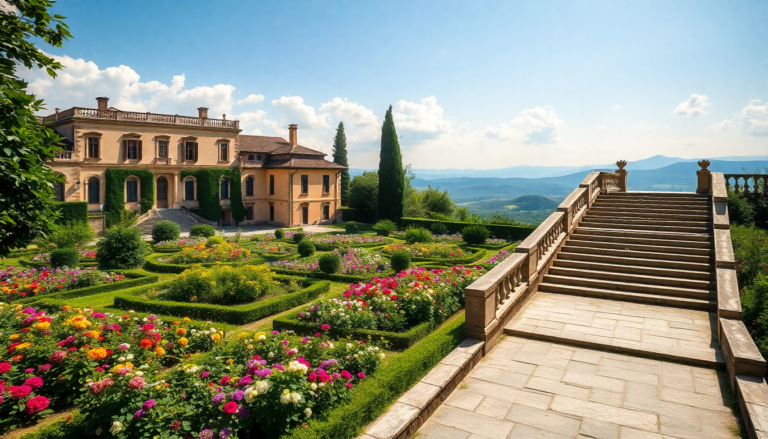Argomenti trattati
- Chalet Pagliuca: A neo-Pompeian gem
- Castello di Fonterutoli: A historical vineyard
- Villa Piacenza: A textile legacy
- Giardino Giusti: A renaissance of colors
- Palazzo del Drago: Artistic splendor in Bolsena
- Villa Pace: Architectural elegance in Friuli
- Abbazia della Cervara: A monastic retreat
- Tonnara Foderà: A glimpse into fishing heritage
Italy is a treasure trove of history and art, and what better way to experience this than through its splendid historic residences? From majestic villas to enchanting gardens, these sites are not just buildings; they encapsulate tales of times long past, resonating with the whispers of history. As we approach the National Day of Historic Residences, set for May 25, 2025, a remarkable opportunity arises: over 450 exclusive locations will open their doors for free visits. So, grab your curiosity and let’s explore some of Italy’s most stunning historic homes!
Chalet Pagliuca: A neo-Pompeian gem
Nestled within a sprawling park adorned with ancient olive trees, fruit-bearing plants, and vibrant roses, Chalet Pagliuca is a sight to behold. Constructed in 1930 in Alvignano, Caserta, this residence captivates visitors with its neo-Pompeian design. The exterior boasts a delicate peristyle supported by slender, fluted columns, while the windows are gracefully topped with Liberty-style frames. But it’s the interior that truly enchants, featuring ceilings inspired by the beautiful frescoes of the House of the Vettii in Pompeii. The garden reflects the elegance of Renaissance Italian gardens, centering around a stunning fountain and a grand entrance staircase. Fun fact: it once welcomed Italy’s first President, Enrico De Nicola, and notable musicians of the time.
Castello di Fonterutoli: A historical vineyard
In the heart of Tuscany lies the medieval charm of Castello di Fonterutoli. This historic residence has been home to the renowned Mazzei family since 1435, spanning 24 generations of viticulture and commerce. As you stroll through its halls, you can almost hear the echoes of Ser Lapo Mazzei, who documented the first known use of the term “Chianti.” During the National Day, you’ll have the chance to explore its impressive winery, a significant architectural project that delves three levels deep, part of the Toscana Wine Architecture circuit. It’s fascinating to think how this place has shaped the landscape of Tuscan wine!
Villa Piacenza: A textile legacy
Located in Pollone, Alto Piemonte, Villa Piacenza is set to open its doors for the first time during the National Day of Historic Residences. This 18th-century residence has been home to the Piacenza family since the mid-19th century. It serves as the headquarters for a foundation that preserves documents related to their long-standing textile trade, dating back to the 17th century. Imagine wandering through the archives, where stories of wool processing and trade come alive, each piece of paper a testament to generations of craftsmanship.
Giardino Giusti: A renaissance of colors
In Verona, the Giardino Giusti offers not just stunning flora but a window into the past. Originally used by the Giusti family for wool dyeing in the 1400s, this site evolved into a representative palace in the Sanmicheli style during the 16th century. The garden itself is a masterpiece, featuring box hedges, cypress trees, fountains, and hidden grottos, and it has absorbed influence from the medicean gardens, becoming a landmark for the cultured elite of the time.
Palazzo del Drago: Artistic splendor in Bolsena
On May 25, the noble floor of Palazzo del Drago in Bolsena will be open to visitors. Situated in the historic center, this structure spans half a hectare, showcasing magnificent frescoed loggias, grand salons, galleries, and even a chapel. The architecture, built in two phases between 1533 and 1561, was influenced by Cardinal Tiberio Crispo, who had close ties with the Farnese family and utilized the finest artists of the time, such as Prospero Fontana. Walking through these halls is like stepping into a living canvas of history.
Villa Pace: Architectural elegance in Friuli
Villa Pace, situated in Campolongo Tapogliano, stands proudly near three UNESCO sites. Built in the mid-1600s by Field Marshal Carlo Maria Pace, this cubic-shaped residence boasts corner towers and a stunning rococo restoration from the 18th century, completed for his marriage. The ellipsoidal stairway and beautifully frescoed halls are a sight that ignites the imagination. One can only wonder about the stories the walls could tell if they could speak!
Abbazia della Cervara: A monastic retreat
In the province of Genoa, the Abbazia della Cervara offers a glimpse into monastic life. Dating back to 1361, this former monastery is perched along the scenic route between Santa Margherita Ligure and Portofino. Its charming quadrangular cloister and a 16th-century tower were constructed for protection against pirates, showcasing the abbey’s storied past. Visitors on May 25 will be able to enjoy the Italian garden and cloister, a peaceful refuge steeped in history.
Tonnara Foderà: A glimpse into fishing heritage
Lastly, don’t miss the Tonnara Foderà in Sicily, a historical tuna fishing complex built by the Foderà family. Positioned between Alcamo Marina and Castellammare, this site still retains much of its original fishing equipment and boats. Imagine the bustling activity that once filled this space as families worked together to maintain traditions that have persisted for generations. A visit here offers not just history but a connection to the sea, a reminder of nature’s enduring role in human life.
Mark your calendars for May 25, as Italy’s historic residences open their doors, inviting you to step back in time and experience their beauty firsthand. Each of these locations is more than just a visit; it’s an opportunity to connect with the rich tapestry of Italian history, art, and culture. So, lace up your walking shoes and prepare to uncover the stories that await!

